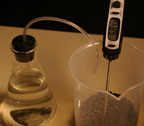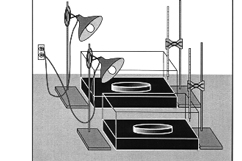

Avoiding Flawed
Demonstrations:
Greenhouse Effect
Intro/Index
Faulty Demos
Errors, Misconceptions
Testing, Lab Results
Scientifically Strong
Resources
Rebuttals
Acknowledgements
Contact

Demonstrations are
now widely promoted
across the United States
in science aquariums
and teacher workshops,
claiming dramatic results.
With the aim to
"dispel myths and
concerns."
This web portal
is a resource within
America's online library
for Education &
Research
in Science,
Technology,
Engineering,
Mathematics:

|
 |


Ask yourself: "Why would energy industry groups do that?"... when engineering advisors know this science well:
Climate change in a shoebox:
Right result, wrong physics
Published May 2010
in American Journal of Physics,
American Association of Physics Teachers
Paul Wagoner -- TERC.
Chunhua Liu &
and R. G. Tobin -- Tufts University
Available on-line on several servers:
Tufts.edu [pdf]
American Journal of Physics
Harvard.edu
Natural Science
Terc news announcement
Abstract of the Wagoner, Liu and Tobin paper
Classroom experiments that purport to demonstrate the
role of carbon dioxide’s far-infrared
absorption in
global climate change are more subtle than is
commonly appreciated. We show, using
both
experimental results and theoretical analysis,
that one such experiment demonstrates an entirely
different phenomenon: The greater density of
carbon dioxide compared to air reduces heat transfer
by suppressing convective mixing with the ambient air.
Other related experiments are subject to
similar concerns.
Argon, which has a density close to that of
carbon dioxide but no infrared
absorption,
provides a
valuable experimental control for separating
radiative from convective
effects. A simple analytical
model for estimating the magnitude of the radiative
greenhouse effect is
presented, and the effect is
shown to be very small for most tabletop experiments.
Thank you, Scott Mandia,
for bringing this essential paper to the attention of
the Mobile Climate Science Labs,
immediately after we
contacted the Climate Science Rapid Response Team
for assistance on this topic.
|

Notes on both papers and their authors:
Neither paper challenges basic global warming, climate change or greenhouse gas theory.
The issue being discussed is whether the demo actually (and accurately) does what it claimed.
Unlike several other flawed demos, the Lueddecke version does not have a major sponsor or promotional campaign backing it.
Yet, the original paper is still being widely accessed as a description of how to do a global warming science demo.
By contrast,
the Wagoner, Liu &
Tobin paper is currently not well known and has been difficult to find.
We believe the Wagoner, Liu and Tobin paper is essential reading
for anyone involved in the design, development and promotion of science demonstrations related to "the greenhouse effect."
Even after the publication of Wagoner, Liu and Tobin's paper, demos are being widely promoted which
make the same basic errors they address. NEED's demo, for example.
The Lueddecke, Pinter, and McManus paper represents a noble and scientific effort to produce great hands-on science.
They addressed a very important need: the world truly must have quality science demonstrations on climate change.
Science and science education is constantly looking to make improvements and correct errors.The peer review process is essential.
This process can be quite strenuous and even quite painful to go through.
Science educators, we feel, should continue to applaud both teams:
Wagoner, Liu &
Tobin
and
Lueddecke, Pinter, and McManus
Together with them, all of us can represent well the "right result" and the right physics in outstanding hands-on science.
|
|



